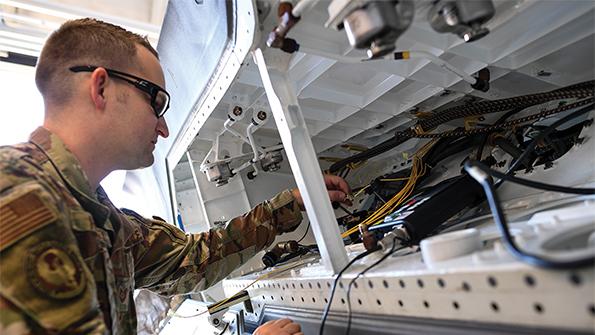
Lockheed Martin’s plan to lower the F-35A’s cost per flight hour to $25,000 by 2025 comes with a caveat worth about $2,852, a sum that could play a major role in the U.S. Air Force’s emerging fighter fleet strategy.
The $33,000 cost per flight hour—a metric expressed in fiscal 2012 dollar values—for each of the Air Force’s roughly 300 F-35As is motivating a search for alternatives.
- Supply-side performance-based logistics deal progresses
- Lockheed plans to cut airframe support costs 40% by 2025
This summer, the Air Force and the Joint Staff are conducting a tactical aircraft fleet study on the options for replacing an aging fleet of Lockheed F-16C/D Block 25s and 30s.
Unless the F-35A’s hourly operating cost becomes more affordable, the program risks losing hundreds of orders over the long term from the Air Force’s official program of record of 1,763 fighters.
But Lockheed’s plan for addressing concerns about the F-35A’s hourly operating costs includes a major limitation. As the airframe supplier, Lockheed directly controls only 39% of the F-35A’s hourly operating cost, a company official says. By contrast, the Air Force controls about 47% of the cost. The F135 engine supplier, Pratt & Whitney, is responsible for the remaining 14%.
In absolute terms, the Air Force’s share of the $33,000 cost per flight hour comes out to $15,510. Lockheed’s share is $12,870, leaving Pratt with $4,620 of the total bill.
By using a variety of tools, including an emerging supply-side performance-based logistics deal and the opening of repair depots, Lockheed believes it has a solid plan to reduce the airframe portion of the cost per flight hour by 40% by the end of fiscal 2025.
Since the company’s cost-saving plan applies only to its $12,870 share of the overall hourly cost, a 40% reduction would cut the F-35A’s hourly cost attributable to the airframe by only $5,148, lowering Lockheed’s share of the overall total to $7,722.
Lockheed’s plan would reduce the cost per flight hour of the F-35A to $27,852, which is still $2,852 higher than the company’s commitment.
To hit the $25,000 target by the end of fiscal 2025, Lockheed needs help from the Air Force and Pratt, which account for $20,130 of the $33,000 hourly cost. Fortunately, neither would be required to match Lockheed’s plan to cut its share of the cost by 40% over the next 4.5 years—the Air Force and Pratt would need to reduce their costs by only 14.2% each.
The Air Force is evaluating “levers” to reduce its portion of the F-35A’s hourly operating cost, Air Force Chief of Staff Gen. Charles Brown, Jr., said in congressional testimony in early June.
But the Air Force’s options are constrained in some cases by enterprise-wide interests. Lockheed, for example, has outlined a seemingly straightforward path for the Air Force to achieve a roughly 33% reduction for line maintenance workforce costs: By cross-training maintainers on multiple systems, the Air Force could cut the number assigned to each F-35A to nine from 12. That proposal, however, might require the Air Force to bifurcate a common pool of aircraft maintainers, creating separate training and career pipelines for the F-35A and the rest of the fighter fleet.
By contrast, Lockheed’s plans to achieve cost savings are well understood. Projected fleet growth over the next five years could add between 240 and 300 F-35As, each equipped with the most reliable hardware produced to date to lower overall repair and replacement costs. Second, Lockheed is planning to stand up dozens of parts-repair depots over the next five years. In the dearth of a parts-replacement capability so far, the program has relied on the more expensive replacement option to fix any broken components. That change, along with a steadily rising pool of spares, is expected to reduce the airframer’s share of the cost dramatically, says Bridget Lauderdale, Lockheed’s vice president and general manager for the F-35A.
Lockheed’s cost-saving strategy received another boost on June 14. The F-35 Joint Program Office published a presolicitation notice for a supply-side performance-based logistics agreement, which might place 60,000 F-35 parts under a five-year supply-chain-management construct fully controlled by Lockheed beginning in 2023. The supply-side proposal narrows the original scope of the F-35 performance-based logistics plan, which included Lockheed ownership of all airframe sustainment.
“At this time, we see the greatest area for improvement within our control today being in supply-chain execution to improve parts availability,” a Lockheed spokesperson says.






Comments
I feel like something's missing here that maybe you can reply to.
Isn't the 47% of the cost that the Air Force controls largely dependent on processes and reliability of the F-35A provided by Lockheed Martin? If that's the case, then I would think it's Lockheed Martin's responsibility to provide more streamlined processes and parts/equipment that don't need as much maintenance?
I would think it's Lockheed Martin's responsibility to reduce the customers maintenance hours/out of pocket expenses by $2,852 (or by about 18.4%).